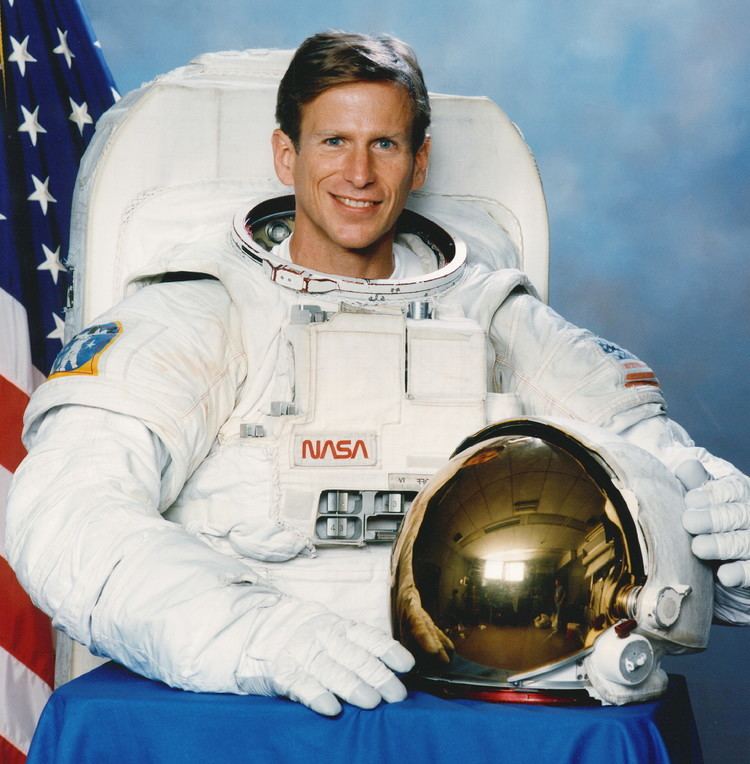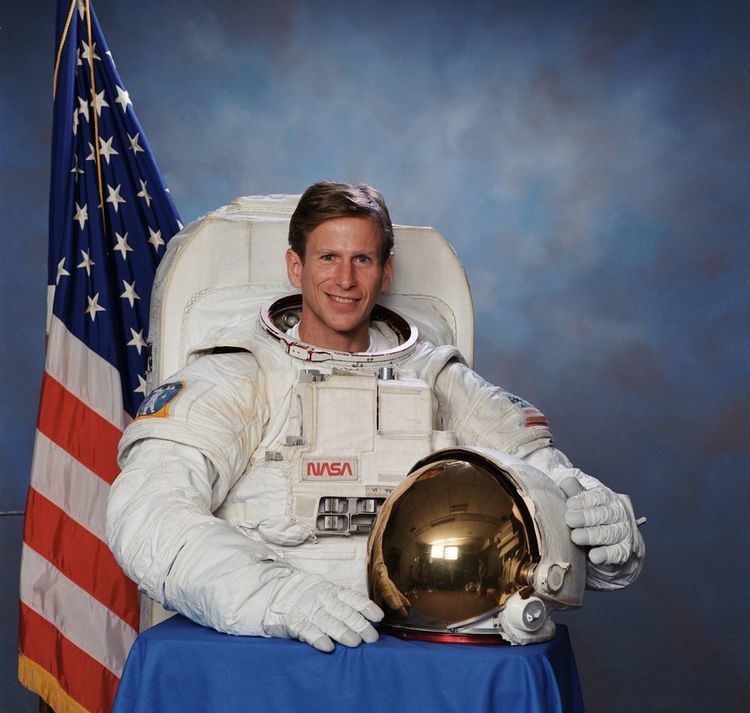Nationality American Mission insignia | Time in space 43d 07h 01m Role Astronaut Status Active Name Michael Gernhardt | |
 | ||
Similar People James F Reilly, James S Voss, Roger K Crouch, Susan Kilrain, Gregory T Linteris | ||
Other occupation Biological engineering | ||
Michael Landon Gernhardt (Ph.D.) (born May 4, 1956, in Mansfield, Ohio) is a NASA astronaut and manager of Environmental Physiology Laboratory and principal investigator of the Prebreathe Reduction Program (PRP) at the Lyndon B. Johnson Space Center.
Contents
- Personal
- Education
- Organizations
- Undersea career
- NASA career
- Spaceflight experience
- Awards and honors
- References

Personal
He enjoys running, swimming, flying, fishing, and scuba diving. His father, George M. Gernhardt is deceased. His mother, Suzanne C. Winters, resides in Whitestone, Virginia.
Education
Organizations
Undersea career
From 1977 to 1984, Gernhardt worked as a professional diver and project engineer on a variety of subsea oil field construction and repair projects around the world. He has logged over 700 deep sea dives and has experience in air, mixed gas, bounce bell and saturation diving. During his diving career Gernhardt attended graduate school at the University of Pennsylvania and developed a new theoretical based on tissue gas bubble dynamics. He then participated in the development and field implementation of a variety of new decompression tables. From 1984 to 1988, Gernhardt worked as Manager and then Vice President of Special Projects for Oceaneering International. During this time he led the development of a telerobotic system for subsea platform cleaning and inspection as well as a variety of new diver and robot tools. In 1988 he founded Oceaneering Space Systems, a company formed to transfer subsea technology and operational experience to the ISS program. From 1988 until his selection by NASA in 1992, he worked on the development of new astronaut and robot-compatible tools for performing maintenance on Space Station Freedom. He also worked on the development of new portable life support systems and decompression procedures for extra-vehicular activity.
NASA career
At NASA, Gernhardt reported to the Johnson Space Center in August 1992. His technical assignments to date include:
Gernhardt presently serves as a member of the astronaut office EVA branch and as Principal Investigator of the Prebreathe Reduction Program and Manager of JSC’s Environmental Physiology Laboratory.
A four-flight veteran, Dr. Gernhardt has logged over 43 days in space, including 4 spacewalks totaling 23 hours and 16 minutes. He was a mission specialist on STS-69 in 1995, STS-83 in 1997, STS-94 in 1997 and STS-104 in 2001.
Gernhardt served as an aquanaut on the first NEEMO (NASA Extreme Environment Mission Operations) crew aboard the Aquarius underwater laboratory in October 2001. In April 2005, he was the commander of the NEEMO 8 mission.
Gernhardt drove the lunar rover prototype at President Barack Obama's inaugural parade on January 20, 2009.
On September 19, 2011, NASA announced that Gernhardt would participate in the NEEMO 15 mission in October 2011 from the DeepWorker submersible. The DeepWorker is a small submarine used as an underwater stand-in for the Space Exploration Vehicle, which might someday be used to explore the surface of an asteroid. In June 2012, Gernhardt piloted the DeepWorker as part of the NEEMO 16 mission, for which he was principal investigator.
Spaceflight experience
STS-69 took place from September 7-September 18, 1995. Its prime objective was the successful deployment and retrieval of a SPARTAN satellite and the Wake Shield Facility (WSF). The WSF was designed to evaluate the effectiveness of using this free-flying experiment to grow semiconductors, high temperature superconductors and other materials using the ultra-high vacuum created behind the spacecraft near the experiment package. Dr. Gernhardt was one of two astronauts to perform a spacewalk to evaluate future Space Station tools and hardware, logging 6 hours and 46 minutes of EVA. Mission duration was 260 hours, 29 minutes, and 8 seconds, traveling 4.5 million miles in 171 orbits of the Earth.
STS-83 took place from April 4-April 8, 1997. This was the Microgravity Science Laboratory (MSL-1) Spacelab mission, was cut short because of problems with one of the Shuttle’s three fuel cell power generation units. Mission duration was 95 hours and 12 minutes, traveling 1.5 million miles in 63 orbits of the Earth.
STS-94 took place from July 1-July 17, 1997. This was a re-flight of the Microgravity Science Laboratory (MSL-1) Spacelab mission, and focused on materials and combustion science research in microgravity. Mission duration was 376 hours and 45 minutes, traveling 6.3 million miles in 251 orbits of the Earth.
STS-104 took place from July 12-July 24, 2001. This was the 10th mission to the International Space Station (ISS). During the 13-day flight the crew conducted joint operations with the Expedition-2 crew. Dr. Gernhardt was one of two astronauts to perform three spacewalks to install the joint airlock “Quest” (including the first US space walk from the ISS) and to outfit it with four high-pressure gas tanks. The mission was accomplished in 200 Earth orbits, traveling 5.3 million miles in 306 hours and 35 minutes.
